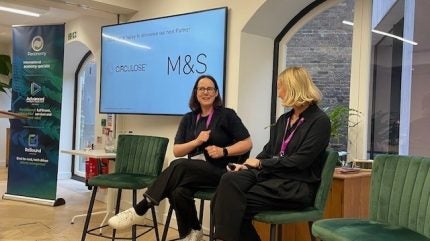
During the British Retail Consortium’s (BRC) annual sustainability summit, M&S’ head of materials and sustainability Katharine Beacham told the audience that a new partnership with Circulose will aid the retailer’s goal of having all products made from sustainable options by 2030.
She said: “We now want to move to next-generation fibres, so this is a really important step to help us get on that journey.”

Discover B2B Marketing That Performs
Combine business intelligence and editorial excellence to reach engaged professionals across 36 leading media platforms.
She explained M&S has an investment committee and a business board and then sign off with the directors is needed. In other words, she said: “There are a lots of layers to work through to move into this kind of partnership.”
But, she added: “It was really good to be able to show H&M and Mango have already taken this step and to highlight how important it is for the industry and for us to get availability of these types of next-generation fibres.”
Beacham also made the point that if “we don’t join these collaborations, then there won’t be the availability of these fibres”.
Plus, she shared it’s “really important that we also have traceability and work with the cutting waste within our supply chain,” so Circulose is giving cutting waste somewhere to be recycled, which makes the whole circularity piece work.

US Tariffs are shifting - will you react or anticipate?
Don’t let policy changes catch you off guard. Stay proactive with real-time data and expert analysis.
By GlobalDataCirculose’s brand partnership director Esther Haitink told the audience she was impressed with M&S’ level of readiness to work with a company like Circulose, which is a recycled cellulose pulp that is used to make rayon fibres, such as viscose.
She shared: “One of the key learnings from us and from working with multiple brands every day is that when there is a clear goal and a clear direction at the heart of the company, these decisions are much easier because you’re plugging into a solution to a problem that a brand already wants to solve.”
When Beacham was quizzed on what the next steps of this partnership will be, she said it will be to engage the parts of the supply chain that will be involved in this product type. It will also be about deciding which products the fibre will go into. And working with product design teams and technologies to make sure the products are mapped out so they can be traced through the supply chain using Circulose’s partnership with textile traceability platform TextileGenesis.
Beacham was keen to point out it will be key to work with the fibre producers to ensure they are linked into the fabric suppliers and garment suppliers throughout the supply chain.
Finally, she said it will be about picking a product range where M&S can get the customer really engaged in this, because she knows that M&S customers really value understanding where a product comes from.
Haitink added that Circulose is keen to invite many more brands to join this journey, stating: “It’s where we need to be as an industry to keep having beautiful clothes as otherwise we’ll have the bigger problem of tapping into very finite resources”.





